Financial Resources and Planning Report: Lilliput Case Study
VerifiedAdded on 2020/01/23
|16
|4722
|331
Report
AI Summary
This report provides a comprehensive analysis of managing financial resources, focusing on a case study of Lilliput, a UK-based kids wear provider. The report explores various sources of finance, including bank loans, venture capitalists, retained earnings, and sales of assets, along with their implications. It delves into the costs associated with different financial sources, the significance of financial planning, and the information needs of stakeholders such as investors, lenders, employees, and managers. Furthermore, the report examines the impact of finance on financial statements, including the preparation of a cash budget and the analysis of financial statements using ratios. The analysis includes assessing the viability of projects using financial tools and comparing the financial statements of different types of firms, with a specific analysis of Sainsbury Plc's financial statements. The report highlights the importance of effective financial management for business expansion and sustainability.
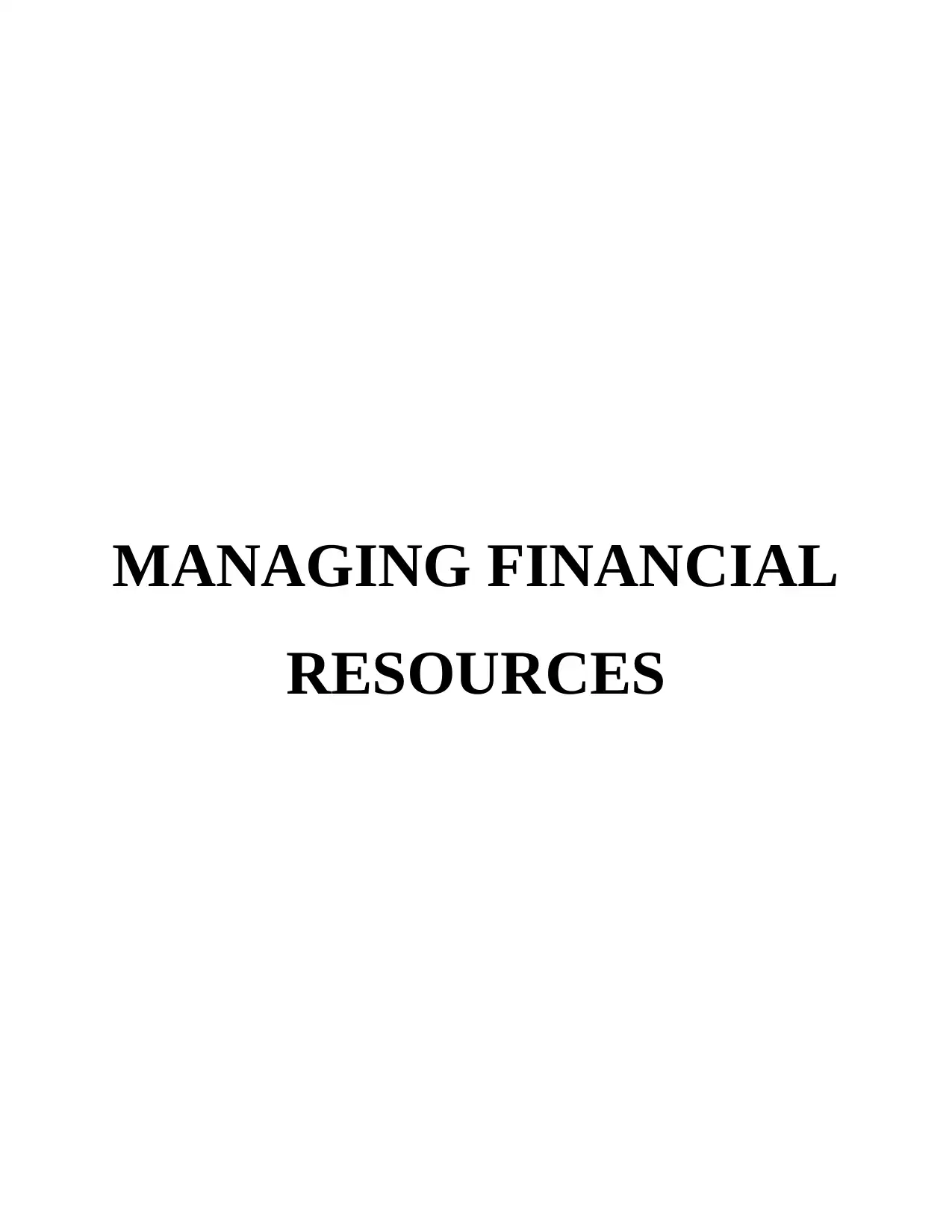
MANAGING FINANCIAL
RESOURCES
RESOURCES
Paraphrase This Document
Need a fresh take? Get an instant paraphrase of this document with our AI Paraphraser
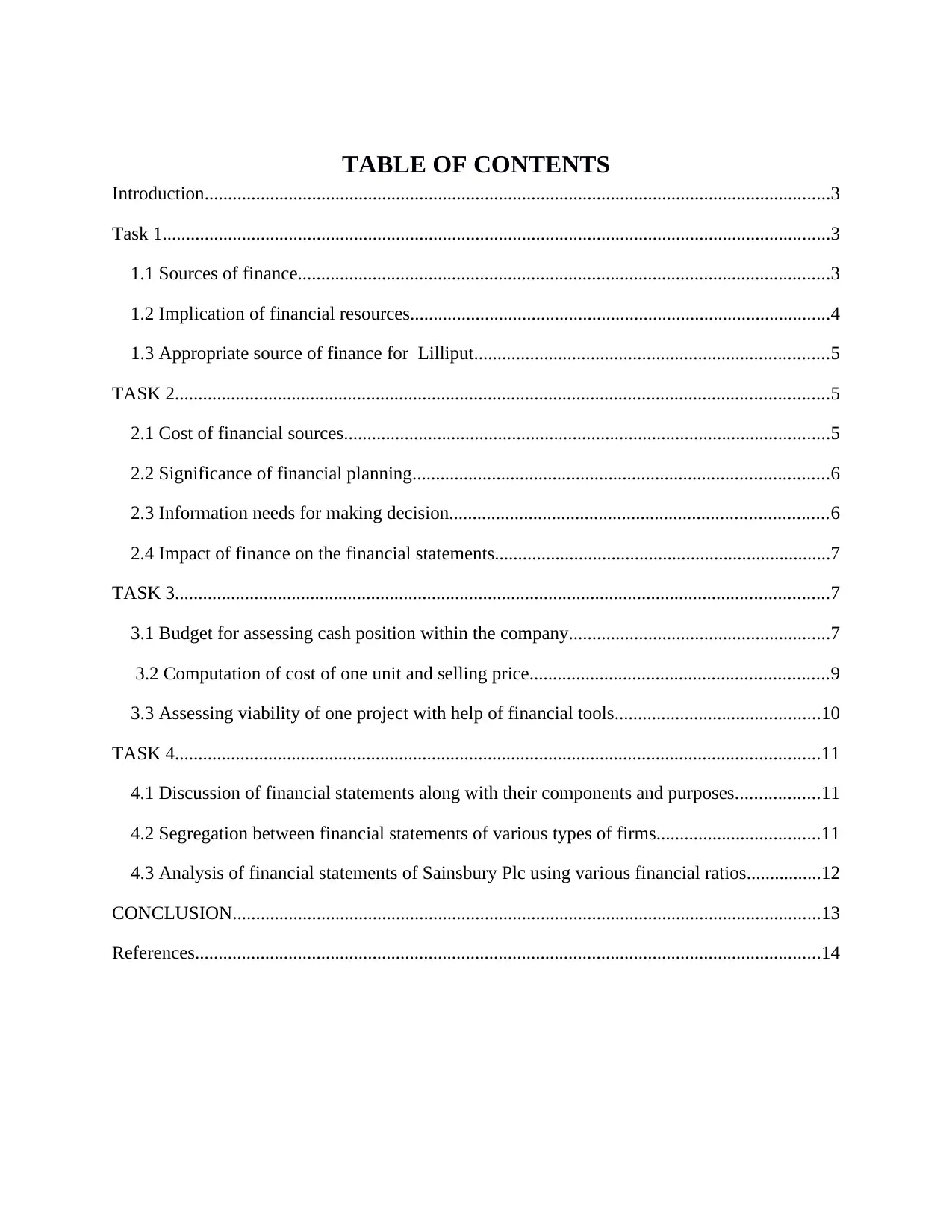
TABLE OF CONTENTS
Introduction......................................................................................................................................3
Task 1...............................................................................................................................................3
1.1 Sources of finance..................................................................................................................3
1.2 Implication of financial resources..........................................................................................4
1.3 Appropriate source of finance for Lilliput............................................................................5
TASK 2............................................................................................................................................5
2.1 Cost of financial sources........................................................................................................5
2.2 Significance of financial planning.........................................................................................6
2.3 Information needs for making decision.................................................................................6
2.4 Impact of finance on the financial statements........................................................................7
TASK 3............................................................................................................................................7
3.1 Budget for assessing cash position within the company........................................................7
3.2 Computation of cost of one unit and selling price................................................................9
3.3 Assessing viability of one project with help of financial tools............................................10
TASK 4..........................................................................................................................................11
4.1 Discussion of financial statements along with their components and purposes..................11
4.2 Segregation between financial statements of various types of firms...................................11
4.3 Analysis of financial statements of Sainsbury Plc using various financial ratios................12
CONCLUSION..............................................................................................................................13
References......................................................................................................................................14
Introduction......................................................................................................................................3
Task 1...............................................................................................................................................3
1.1 Sources of finance..................................................................................................................3
1.2 Implication of financial resources..........................................................................................4
1.3 Appropriate source of finance for Lilliput............................................................................5
TASK 2............................................................................................................................................5
2.1 Cost of financial sources........................................................................................................5
2.2 Significance of financial planning.........................................................................................6
2.3 Information needs for making decision.................................................................................6
2.4 Impact of finance on the financial statements........................................................................7
TASK 3............................................................................................................................................7
3.1 Budget for assessing cash position within the company........................................................7
3.2 Computation of cost of one unit and selling price................................................................9
3.3 Assessing viability of one project with help of financial tools............................................10
TASK 4..........................................................................................................................................11
4.1 Discussion of financial statements along with their components and purposes..................11
4.2 Segregation between financial statements of various types of firms...................................11
4.3 Analysis of financial statements of Sainsbury Plc using various financial ratios................12
CONCLUSION..............................................................................................................................13
References......................................................................................................................................14
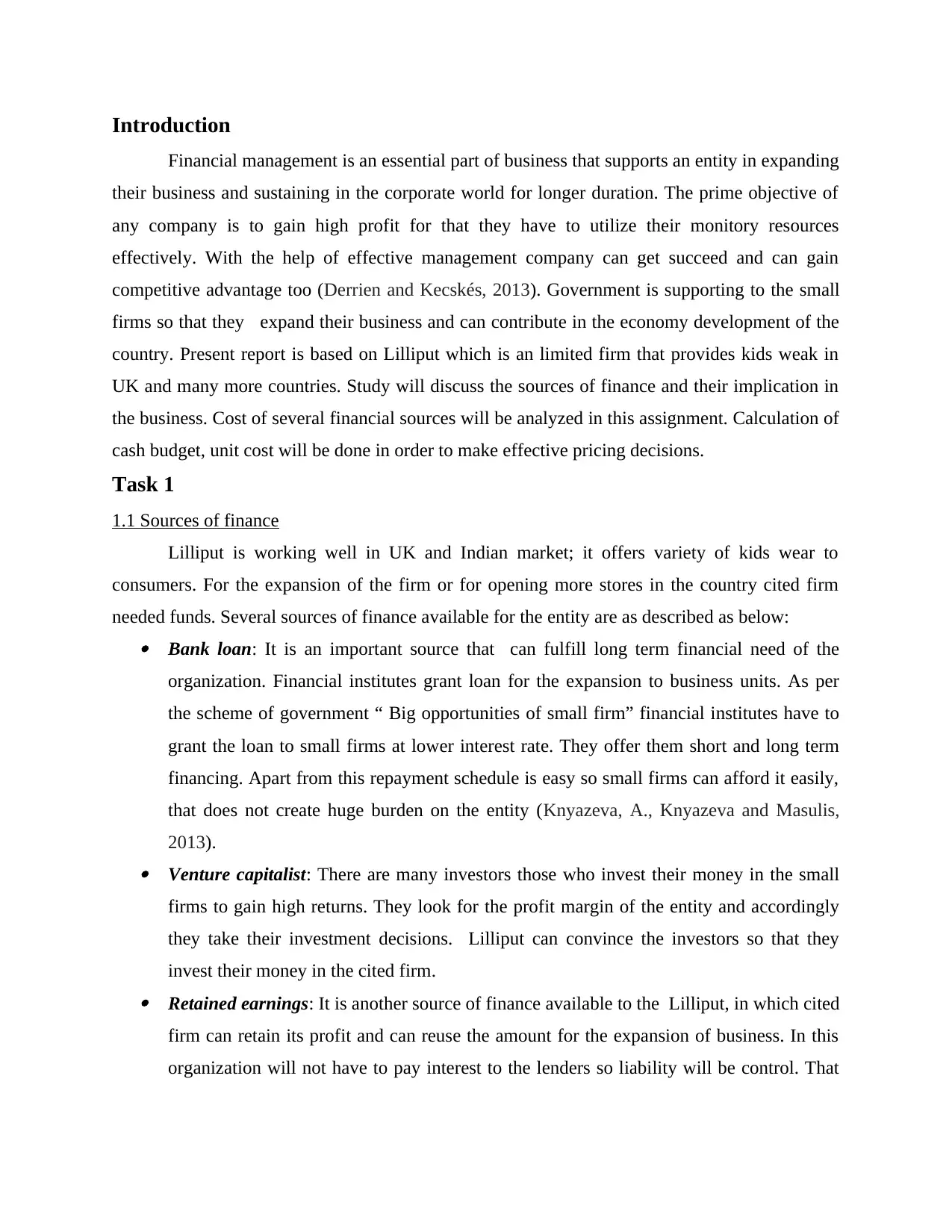
Introduction
Financial management is an essential part of business that supports an entity in expanding
their business and sustaining in the corporate world for longer duration. The prime objective of
any company is to gain high profit for that they have to utilize their monitory resources
effectively. With the help of effective management company can get succeed and can gain
competitive advantage too (Derrien and Kecskés, 2013). Government is supporting to the small
firms so that they expand their business and can contribute in the economy development of the
country. Present report is based on Lilliput which is an limited firm that provides kids weak in
UK and many more countries. Study will discuss the sources of finance and their implication in
the business. Cost of several financial sources will be analyzed in this assignment. Calculation of
cash budget, unit cost will be done in order to make effective pricing decisions.
Task 1
1.1 Sources of finance
Lilliput is working well in UK and Indian market; it offers variety of kids wear to
consumers. For the expansion of the firm or for opening more stores in the country cited firm
needed funds. Several sources of finance available for the entity are as described as below: Bank loan: It is an important source that can fulfill long term financial need of the
organization. Financial institutes grant loan for the expansion to business units. As per
the scheme of government “ Big opportunities of small firm” financial institutes have to
grant the loan to small firms at lower interest rate. They offer them short and long term
financing. Apart from this repayment schedule is easy so small firms can afford it easily,
that does not create huge burden on the entity (Knyazeva, A., Knyazeva and Masulis,
2013). Venture capitalist: There are many investors those who invest their money in the small
firms to gain high returns. They look for the profit margin of the entity and accordingly
they take their investment decisions. Lilliput can convince the investors so that they
invest their money in the cited firm. Retained earnings: It is another source of finance available to the Lilliput, in which cited
firm can retain its profit and can reuse the amount for the expansion of business. In this
organization will not have to pay interest to the lenders so liability will be control. That
Financial management is an essential part of business that supports an entity in expanding
their business and sustaining in the corporate world for longer duration. The prime objective of
any company is to gain high profit for that they have to utilize their monitory resources
effectively. With the help of effective management company can get succeed and can gain
competitive advantage too (Derrien and Kecskés, 2013). Government is supporting to the small
firms so that they expand their business and can contribute in the economy development of the
country. Present report is based on Lilliput which is an limited firm that provides kids weak in
UK and many more countries. Study will discuss the sources of finance and their implication in
the business. Cost of several financial sources will be analyzed in this assignment. Calculation of
cash budget, unit cost will be done in order to make effective pricing decisions.
Task 1
1.1 Sources of finance
Lilliput is working well in UK and Indian market; it offers variety of kids wear to
consumers. For the expansion of the firm or for opening more stores in the country cited firm
needed funds. Several sources of finance available for the entity are as described as below: Bank loan: It is an important source that can fulfill long term financial need of the
organization. Financial institutes grant loan for the expansion to business units. As per
the scheme of government “ Big opportunities of small firm” financial institutes have to
grant the loan to small firms at lower interest rate. They offer them short and long term
financing. Apart from this repayment schedule is easy so small firms can afford it easily,
that does not create huge burden on the entity (Knyazeva, A., Knyazeva and Masulis,
2013). Venture capitalist: There are many investors those who invest their money in the small
firms to gain high returns. They look for the profit margin of the entity and accordingly
they take their investment decisions. Lilliput can convince the investors so that they
invest their money in the cited firm. Retained earnings: It is another source of finance available to the Lilliput, in which cited
firm can retain its profit and can reuse the amount for the expansion of business. In this
organization will not have to pay interest to the lenders so liability will be control. That
⊘ This is a preview!⊘
Do you want full access?
Subscribe today to unlock all pages.

Trusted by 1+ million students worldwide
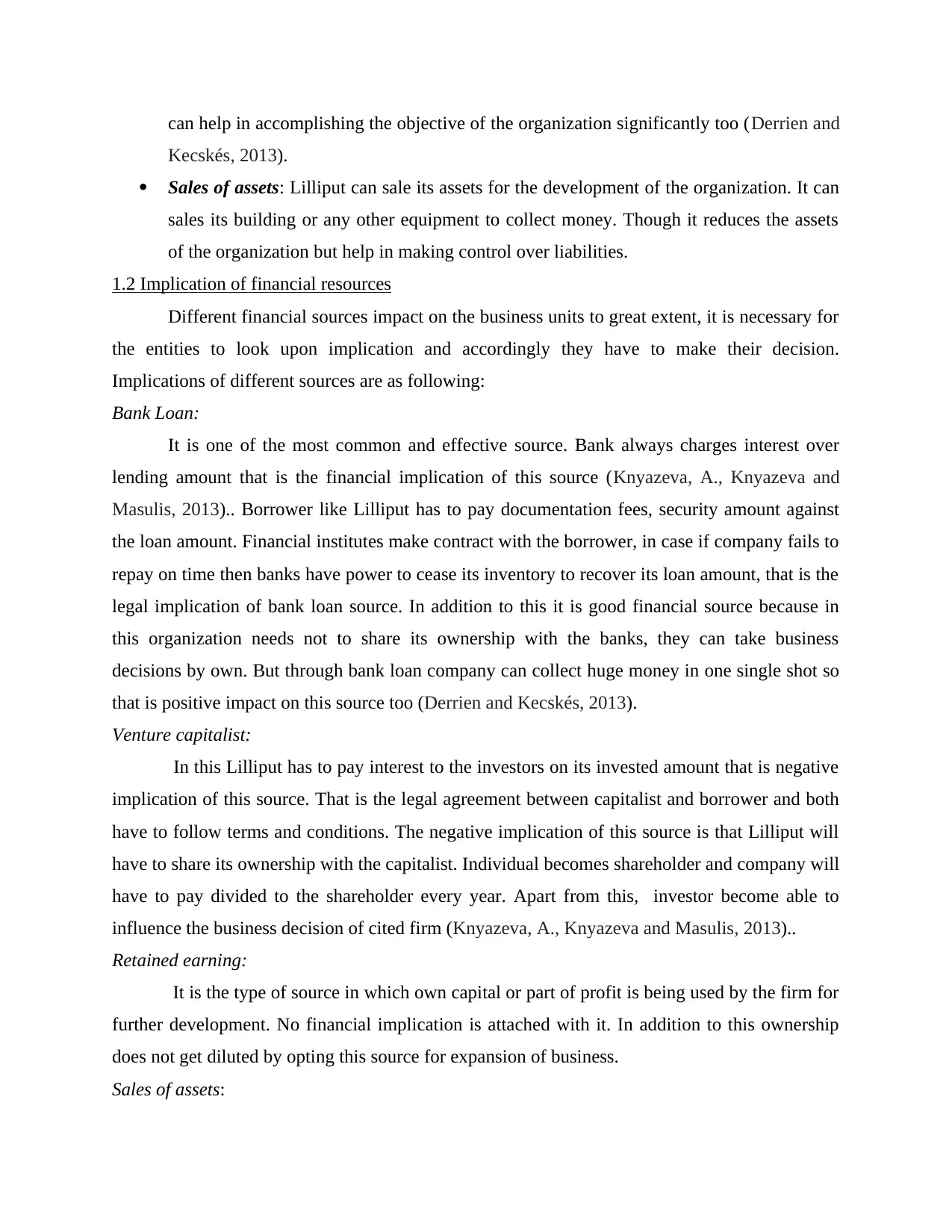
can help in accomplishing the objective of the organization significantly too (Derrien and
Kecskés, 2013).
Sales of assets: Lilliput can sale its assets for the development of the organization. It can
sales its building or any other equipment to collect money. Though it reduces the assets
of the organization but help in making control over liabilities.
1.2 Implication of financial resources
Different financial sources impact on the business units to great extent, it is necessary for
the entities to look upon implication and accordingly they have to make their decision.
Implications of different sources are as following:
Bank Loan:
It is one of the most common and effective source. Bank always charges interest over
lending amount that is the financial implication of this source (Knyazeva, A., Knyazeva and
Masulis, 2013).. Borrower like Lilliput has to pay documentation fees, security amount against
the loan amount. Financial institutes make contract with the borrower, in case if company fails to
repay on time then banks have power to cease its inventory to recover its loan amount, that is the
legal implication of bank loan source. In addition to this it is good financial source because in
this organization needs not to share its ownership with the banks, they can take business
decisions by own. But through bank loan company can collect huge money in one single shot so
that is positive impact on this source too (Derrien and Kecskés, 2013).
Venture capitalist:
In this Lilliput has to pay interest to the investors on its invested amount that is negative
implication of this source. That is the legal agreement between capitalist and borrower and both
have to follow terms and conditions. The negative implication of this source is that Lilliput will
have to share its ownership with the capitalist. Individual becomes shareholder and company will
have to pay divided to the shareholder every year. Apart from this, investor become able to
influence the business decision of cited firm (Knyazeva, A., Knyazeva and Masulis, 2013)..
Retained earning:
It is the type of source in which own capital or part of profit is being used by the firm for
further development. No financial implication is attached with it. In addition to this ownership
does not get diluted by opting this source for expansion of business.
Sales of assets:
Kecskés, 2013).
Sales of assets: Lilliput can sale its assets for the development of the organization. It can
sales its building or any other equipment to collect money. Though it reduces the assets
of the organization but help in making control over liabilities.
1.2 Implication of financial resources
Different financial sources impact on the business units to great extent, it is necessary for
the entities to look upon implication and accordingly they have to make their decision.
Implications of different sources are as following:
Bank Loan:
It is one of the most common and effective source. Bank always charges interest over
lending amount that is the financial implication of this source (Knyazeva, A., Knyazeva and
Masulis, 2013).. Borrower like Lilliput has to pay documentation fees, security amount against
the loan amount. Financial institutes make contract with the borrower, in case if company fails to
repay on time then banks have power to cease its inventory to recover its loan amount, that is the
legal implication of bank loan source. In addition to this it is good financial source because in
this organization needs not to share its ownership with the banks, they can take business
decisions by own. But through bank loan company can collect huge money in one single shot so
that is positive impact on this source too (Derrien and Kecskés, 2013).
Venture capitalist:
In this Lilliput has to pay interest to the investors on its invested amount that is negative
implication of this source. That is the legal agreement between capitalist and borrower and both
have to follow terms and conditions. The negative implication of this source is that Lilliput will
have to share its ownership with the capitalist. Individual becomes shareholder and company will
have to pay divided to the shareholder every year. Apart from this, investor become able to
influence the business decision of cited firm (Knyazeva, A., Knyazeva and Masulis, 2013)..
Retained earning:
It is the type of source in which own capital or part of profit is being used by the firm for
further development. No financial implication is attached with it. In addition to this ownership
does not get diluted by opting this source for expansion of business.
Sales of assets:
Paraphrase This Document
Need a fresh take? Get an instant paraphrase of this document with our AI Paraphraser
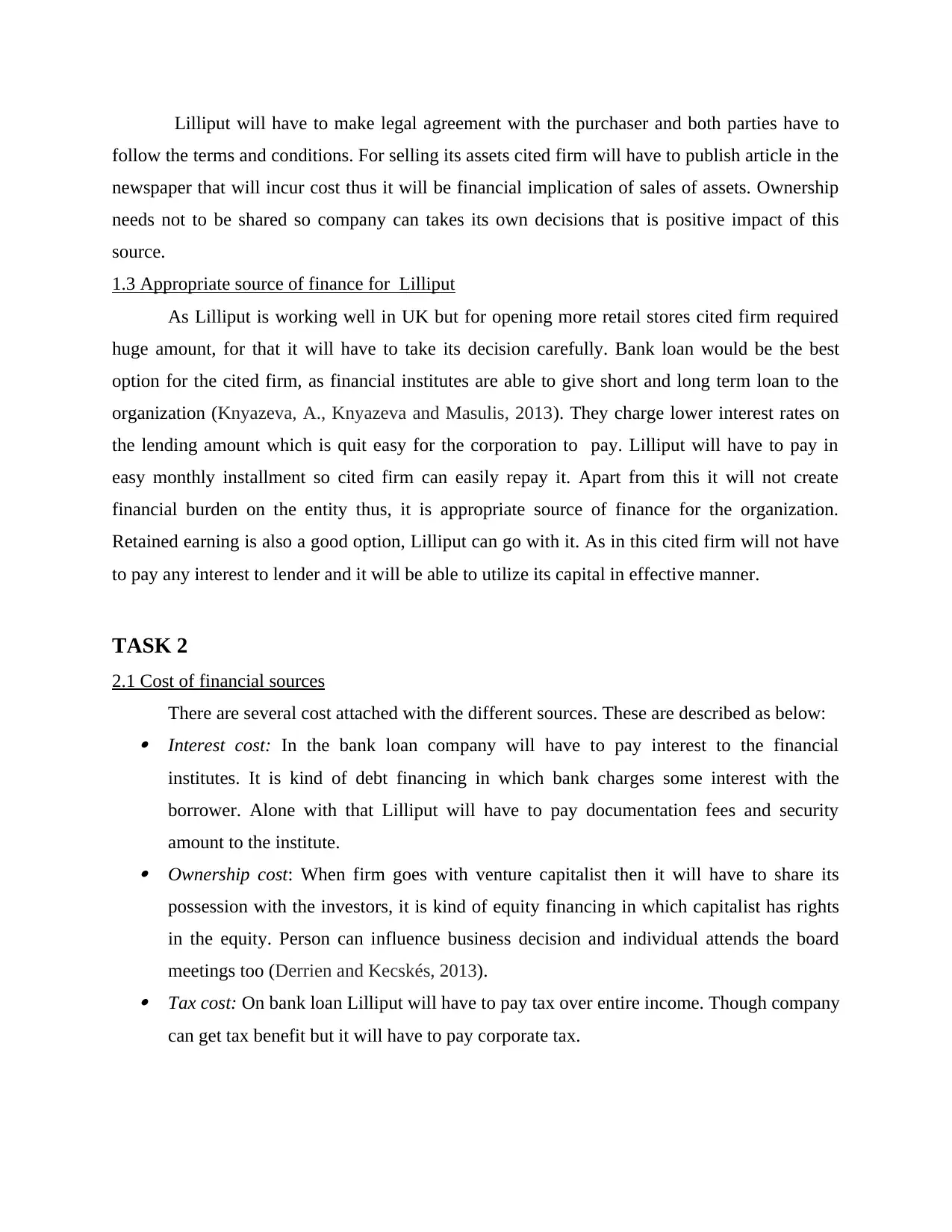
Lilliput will have to make legal agreement with the purchaser and both parties have to
follow the terms and conditions. For selling its assets cited firm will have to publish article in the
newspaper that will incur cost thus it will be financial implication of sales of assets. Ownership
needs not to be shared so company can takes its own decisions that is positive impact of this
source.
1.3 Appropriate source of finance for Lilliput
As Lilliput is working well in UK but for opening more retail stores cited firm required
huge amount, for that it will have to take its decision carefully. Bank loan would be the best
option for the cited firm, as financial institutes are able to give short and long term loan to the
organization (Knyazeva, A., Knyazeva and Masulis, 2013). They charge lower interest rates on
the lending amount which is quit easy for the corporation to pay. Lilliput will have to pay in
easy monthly installment so cited firm can easily repay it. Apart from this it will not create
financial burden on the entity thus, it is appropriate source of finance for the organization.
Retained earning is also a good option, Lilliput can go with it. As in this cited firm will not have
to pay any interest to lender and it will be able to utilize its capital in effective manner.
TASK 2
2.1 Cost of financial sources
There are several cost attached with the different sources. These are described as below: Interest cost: In the bank loan company will have to pay interest to the financial
institutes. It is kind of debt financing in which bank charges some interest with the
borrower. Alone with that Lilliput will have to pay documentation fees and security
amount to the institute. Ownership cost: When firm goes with venture capitalist then it will have to share its
possession with the investors, it is kind of equity financing in which capitalist has rights
in the equity. Person can influence business decision and individual attends the board
meetings too (Derrien and Kecskés, 2013). Tax cost: On bank loan Lilliput will have to pay tax over entire income. Though company
can get tax benefit but it will have to pay corporate tax.
follow the terms and conditions. For selling its assets cited firm will have to publish article in the
newspaper that will incur cost thus it will be financial implication of sales of assets. Ownership
needs not to be shared so company can takes its own decisions that is positive impact of this
source.
1.3 Appropriate source of finance for Lilliput
As Lilliput is working well in UK but for opening more retail stores cited firm required
huge amount, for that it will have to take its decision carefully. Bank loan would be the best
option for the cited firm, as financial institutes are able to give short and long term loan to the
organization (Knyazeva, A., Knyazeva and Masulis, 2013). They charge lower interest rates on
the lending amount which is quit easy for the corporation to pay. Lilliput will have to pay in
easy monthly installment so cited firm can easily repay it. Apart from this it will not create
financial burden on the entity thus, it is appropriate source of finance for the organization.
Retained earning is also a good option, Lilliput can go with it. As in this cited firm will not have
to pay any interest to lender and it will be able to utilize its capital in effective manner.
TASK 2
2.1 Cost of financial sources
There are several cost attached with the different sources. These are described as below: Interest cost: In the bank loan company will have to pay interest to the financial
institutes. It is kind of debt financing in which bank charges some interest with the
borrower. Alone with that Lilliput will have to pay documentation fees and security
amount to the institute. Ownership cost: When firm goes with venture capitalist then it will have to share its
possession with the investors, it is kind of equity financing in which capitalist has rights
in the equity. Person can influence business decision and individual attends the board
meetings too (Derrien and Kecskés, 2013). Tax cost: On bank loan Lilliput will have to pay tax over entire income. Though company
can get tax benefit but it will have to pay corporate tax.
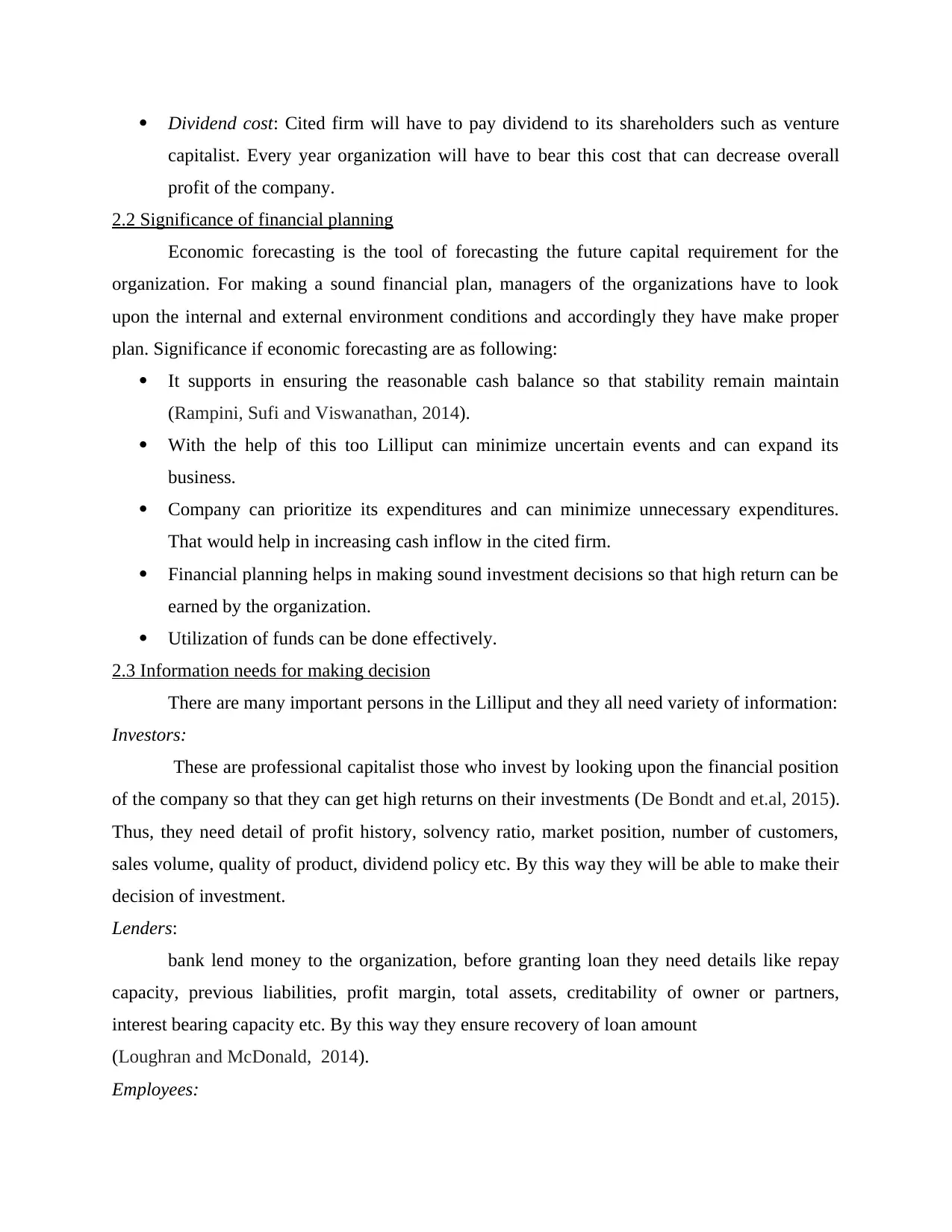
Dividend cost: Cited firm will have to pay dividend to its shareholders such as venture
capitalist. Every year organization will have to bear this cost that can decrease overall
profit of the company.
2.2 Significance of financial planning
Economic forecasting is the tool of forecasting the future capital requirement for the
organization. For making a sound financial plan, managers of the organizations have to look
upon the internal and external environment conditions and accordingly they have make proper
plan. Significance if economic forecasting are as following:
It supports in ensuring the reasonable cash balance so that stability remain maintain
(Rampini, Sufi and Viswanathan, 2014).
With the help of this too Lilliput can minimize uncertain events and can expand its
business.
Company can prioritize its expenditures and can minimize unnecessary expenditures.
That would help in increasing cash inflow in the cited firm.
Financial planning helps in making sound investment decisions so that high return can be
earned by the organization.
Utilization of funds can be done effectively.
2.3 Information needs for making decision
There are many important persons in the Lilliput and they all need variety of information:
Investors:
These are professional capitalist those who invest by looking upon the financial position
of the company so that they can get high returns on their investments (De Bondt and et.al, 2015).
Thus, they need detail of profit history, solvency ratio, market position, number of customers,
sales volume, quality of product, dividend policy etc. By this way they will be able to make their
decision of investment.
Lenders:
bank lend money to the organization, before granting loan they need details like repay
capacity, previous liabilities, profit margin, total assets, creditability of owner or partners,
interest bearing capacity etc. By this way they ensure recovery of loan amount
(Loughran and McDonald, 2014).
Employees:
capitalist. Every year organization will have to bear this cost that can decrease overall
profit of the company.
2.2 Significance of financial planning
Economic forecasting is the tool of forecasting the future capital requirement for the
organization. For making a sound financial plan, managers of the organizations have to look
upon the internal and external environment conditions and accordingly they have make proper
plan. Significance if economic forecasting are as following:
It supports in ensuring the reasonable cash balance so that stability remain maintain
(Rampini, Sufi and Viswanathan, 2014).
With the help of this too Lilliput can minimize uncertain events and can expand its
business.
Company can prioritize its expenditures and can minimize unnecessary expenditures.
That would help in increasing cash inflow in the cited firm.
Financial planning helps in making sound investment decisions so that high return can be
earned by the organization.
Utilization of funds can be done effectively.
2.3 Information needs for making decision
There are many important persons in the Lilliput and they all need variety of information:
Investors:
These are professional capitalist those who invest by looking upon the financial position
of the company so that they can get high returns on their investments (De Bondt and et.al, 2015).
Thus, they need detail of profit history, solvency ratio, market position, number of customers,
sales volume, quality of product, dividend policy etc. By this way they will be able to make their
decision of investment.
Lenders:
bank lend money to the organization, before granting loan they need details like repay
capacity, previous liabilities, profit margin, total assets, creditability of owner or partners,
interest bearing capacity etc. By this way they ensure recovery of loan amount
(Loughran and McDonald, 2014).
Employees:
⊘ This is a preview!⊘
Do you want full access?
Subscribe today to unlock all pages.

Trusted by 1+ million students worldwide
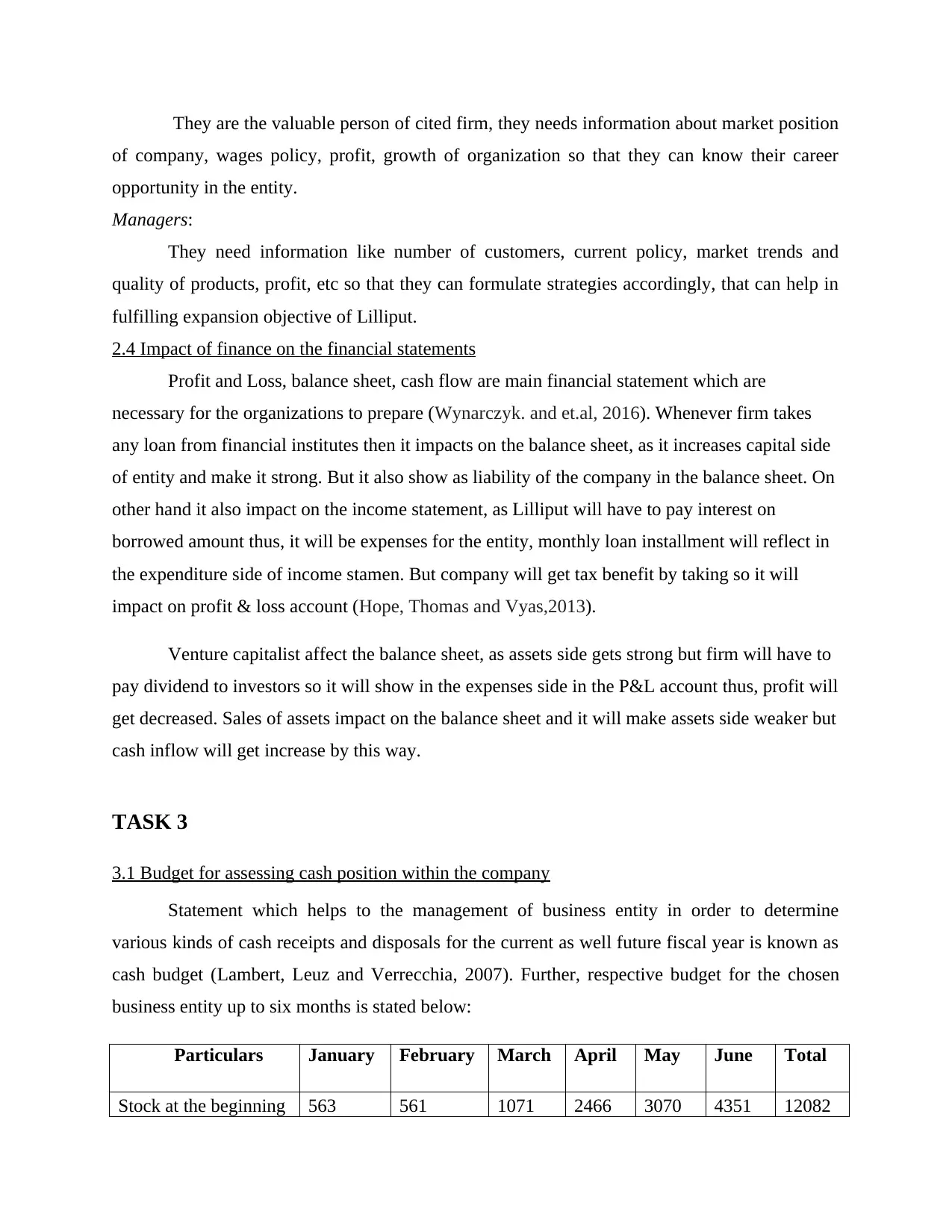
They are the valuable person of cited firm, they needs information about market position
of company, wages policy, profit, growth of organization so that they can know their career
opportunity in the entity.
Managers:
They need information like number of customers, current policy, market trends and
quality of products, profit, etc so that they can formulate strategies accordingly, that can help in
fulfilling expansion objective of Lilliput.
2.4 Impact of finance on the financial statements
Profit and Loss, balance sheet, cash flow are main financial statement which are
necessary for the organizations to prepare (Wynarczyk. and et.al, 2016). Whenever firm takes
any loan from financial institutes then it impacts on the balance sheet, as it increases capital side
of entity and make it strong. But it also show as liability of the company in the balance sheet. On
other hand it also impact on the income statement, as Lilliput will have to pay interest on
borrowed amount thus, it will be expenses for the entity, monthly loan installment will reflect in
the expenditure side of income stamen. But company will get tax benefit by taking so it will
impact on profit & loss account (Hope, Thomas and Vyas,2013).
Venture capitalist affect the balance sheet, as assets side gets strong but firm will have to
pay dividend to investors so it will show in the expenses side in the P&L account thus, profit will
get decreased. Sales of assets impact on the balance sheet and it will make assets side weaker but
cash inflow will get increase by this way.
TASK 3
3.1 Budget for assessing cash position within the company
Statement which helps to the management of business entity in order to determine
various kinds of cash receipts and disposals for the current as well future fiscal year is known as
cash budget (Lambert, Leuz and Verrecchia, 2007). Further, respective budget for the chosen
business entity up to six months is stated below:
Particulars January February March April May June Total
Stock at the beginning 563 561 1071 2466 3070 4351 12082
of company, wages policy, profit, growth of organization so that they can know their career
opportunity in the entity.
Managers:
They need information like number of customers, current policy, market trends and
quality of products, profit, etc so that they can formulate strategies accordingly, that can help in
fulfilling expansion objective of Lilliput.
2.4 Impact of finance on the financial statements
Profit and Loss, balance sheet, cash flow are main financial statement which are
necessary for the organizations to prepare (Wynarczyk. and et.al, 2016). Whenever firm takes
any loan from financial institutes then it impacts on the balance sheet, as it increases capital side
of entity and make it strong. But it also show as liability of the company in the balance sheet. On
other hand it also impact on the income statement, as Lilliput will have to pay interest on
borrowed amount thus, it will be expenses for the entity, monthly loan installment will reflect in
the expenditure side of income stamen. But company will get tax benefit by taking so it will
impact on profit & loss account (Hope, Thomas and Vyas,2013).
Venture capitalist affect the balance sheet, as assets side gets strong but firm will have to
pay dividend to investors so it will show in the expenses side in the P&L account thus, profit will
get decreased. Sales of assets impact on the balance sheet and it will make assets side weaker but
cash inflow will get increase by this way.
TASK 3
3.1 Budget for assessing cash position within the company
Statement which helps to the management of business entity in order to determine
various kinds of cash receipts and disposals for the current as well future fiscal year is known as
cash budget (Lambert, Leuz and Verrecchia, 2007). Further, respective budget for the chosen
business entity up to six months is stated below:
Particulars January February March April May June Total
Stock at the beginning 563 561 1071 2466 3070 4351 12082
Paraphrase This Document
Need a fresh take? Get an instant paraphrase of this document with our AI Paraphraser
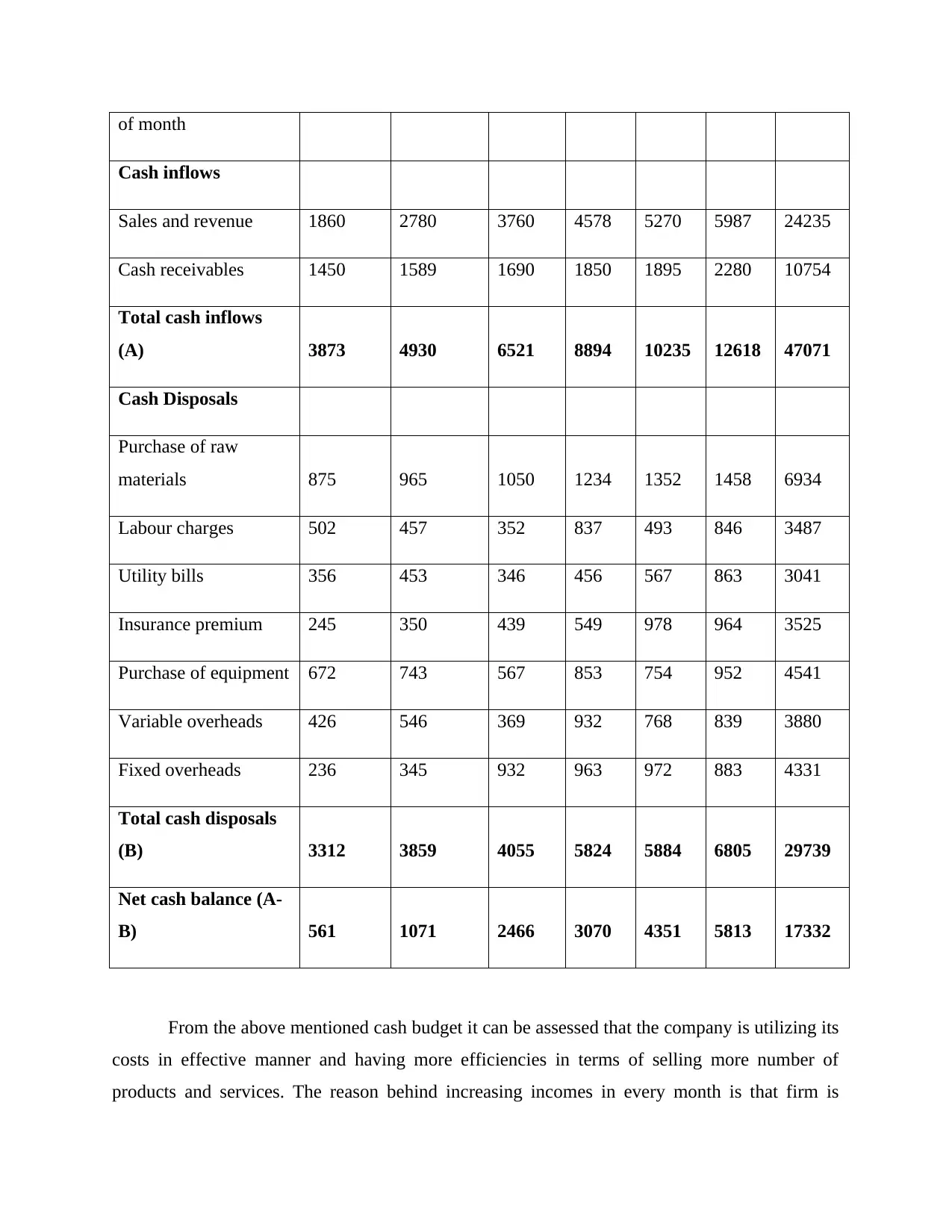
of month
Cash inflows
Sales and revenue 1860 2780 3760 4578 5270 5987 24235
Cash receivables 1450 1589 1690 1850 1895 2280 10754
Total cash inflows
(A) 3873 4930 6521 8894 10235 12618 47071
Cash Disposals
Purchase of raw
materials 875 965 1050 1234 1352 1458 6934
Labour charges 502 457 352 837 493 846 3487
Utility bills 356 453 346 456 567 863 3041
Insurance premium 245 350 439 549 978 964 3525
Purchase of equipment 672 743 567 853 754 952 4541
Variable overheads 426 546 369 932 768 839 3880
Fixed overheads 236 345 932 963 972 883 4331
Total cash disposals
(B) 3312 3859 4055 5824 5884 6805 29739
Net cash balance (A-
B) 561 1071 2466 3070 4351 5813 17332
From the above mentioned cash budget it can be assessed that the company is utilizing its
costs in effective manner and having more efficiencies in terms of selling more number of
products and services. The reason behind increasing incomes in every month is that firm is
Cash inflows
Sales and revenue 1860 2780 3760 4578 5270 5987 24235
Cash receivables 1450 1589 1690 1850 1895 2280 10754
Total cash inflows
(A) 3873 4930 6521 8894 10235 12618 47071
Cash Disposals
Purchase of raw
materials 875 965 1050 1234 1352 1458 6934
Labour charges 502 457 352 837 493 846 3487
Utility bills 356 453 346 456 567 863 3041
Insurance premium 245 350 439 549 978 964 3525
Purchase of equipment 672 743 567 853 754 952 4541
Variable overheads 426 546 369 932 768 839 3880
Fixed overheads 236 345 932 963 972 883 4331
Total cash disposals
(B) 3312 3859 4055 5824 5884 6805 29739
Net cash balance (A-
B) 561 1071 2466 3070 4351 5813 17332
From the above mentioned cash budget it can be assessed that the company is utilizing its
costs in effective manner and having more efficiencies in terms of selling more number of
products and services. The reason behind increasing incomes in every month is that firm is
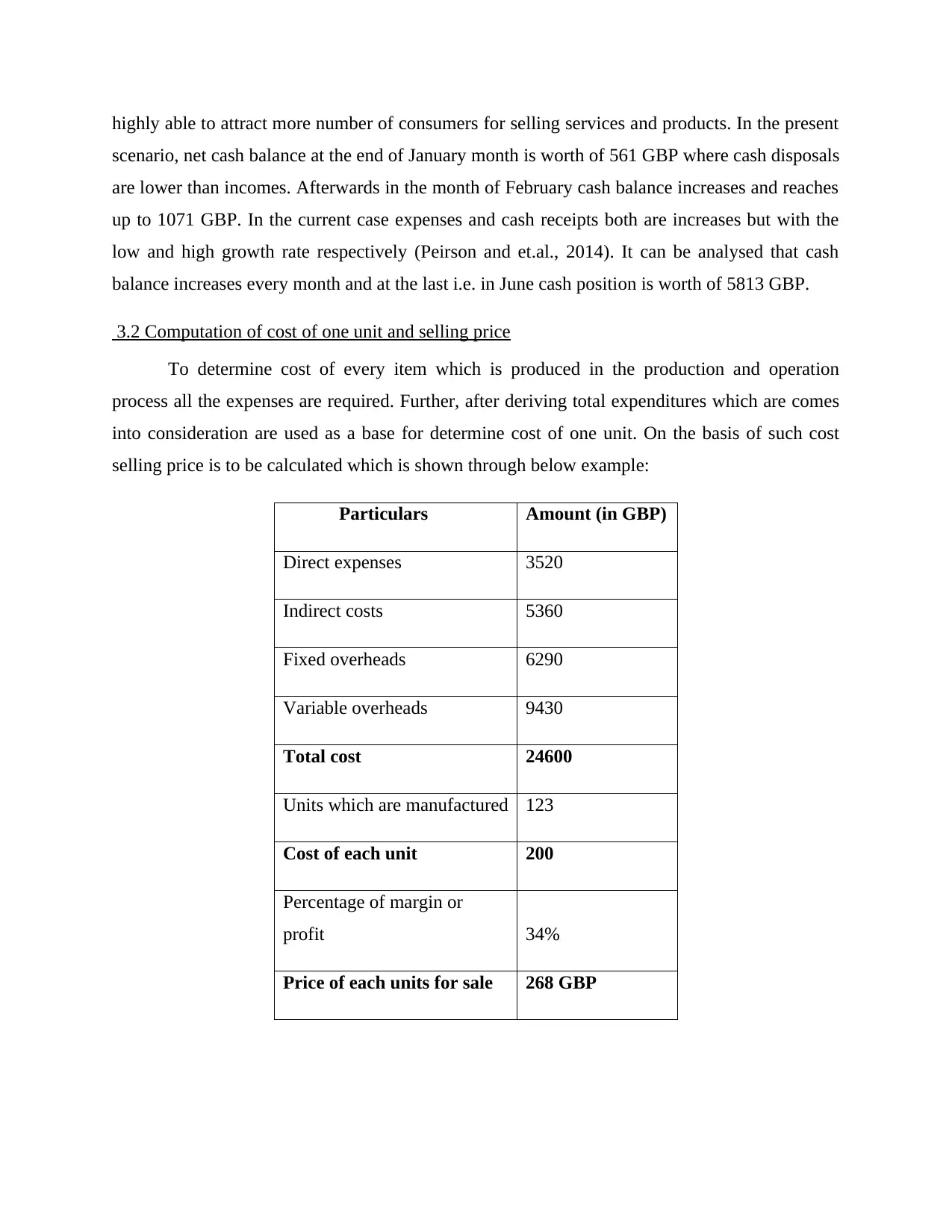
highly able to attract more number of consumers for selling services and products. In the present
scenario, net cash balance at the end of January month is worth of 561 GBP where cash disposals
are lower than incomes. Afterwards in the month of February cash balance increases and reaches
up to 1071 GBP. In the current case expenses and cash receipts both are increases but with the
low and high growth rate respectively (Peirson and et.al., 2014). It can be analysed that cash
balance increases every month and at the last i.e. in June cash position is worth of 5813 GBP.
3.2 Computation of cost of one unit and selling price
To determine cost of every item which is produced in the production and operation
process all the expenses are required. Further, after deriving total expenditures which are comes
into consideration are used as a base for determine cost of one unit. On the basis of such cost
selling price is to be calculated which is shown through below example:
Particulars Amount (in GBP)
Direct expenses 3520
Indirect costs 5360
Fixed overheads 6290
Variable overheads 9430
Total cost 24600
Units which are manufactured 123
Cost of each unit 200
Percentage of margin or
profit 34%
Price of each units for sale 268 GBP
scenario, net cash balance at the end of January month is worth of 561 GBP where cash disposals
are lower than incomes. Afterwards in the month of February cash balance increases and reaches
up to 1071 GBP. In the current case expenses and cash receipts both are increases but with the
low and high growth rate respectively (Peirson and et.al., 2014). It can be analysed that cash
balance increases every month and at the last i.e. in June cash position is worth of 5813 GBP.
3.2 Computation of cost of one unit and selling price
To determine cost of every item which is produced in the production and operation
process all the expenses are required. Further, after deriving total expenditures which are comes
into consideration are used as a base for determine cost of one unit. On the basis of such cost
selling price is to be calculated which is shown through below example:
Particulars Amount (in GBP)
Direct expenses 3520
Indirect costs 5360
Fixed overheads 6290
Variable overheads 9430
Total cost 24600
Units which are manufactured 123
Cost of each unit 200
Percentage of margin or
profit 34%
Price of each units for sale 268 GBP
⊘ This is a preview!⊘
Do you want full access?
Subscribe today to unlock all pages.

Trusted by 1+ million students worldwide
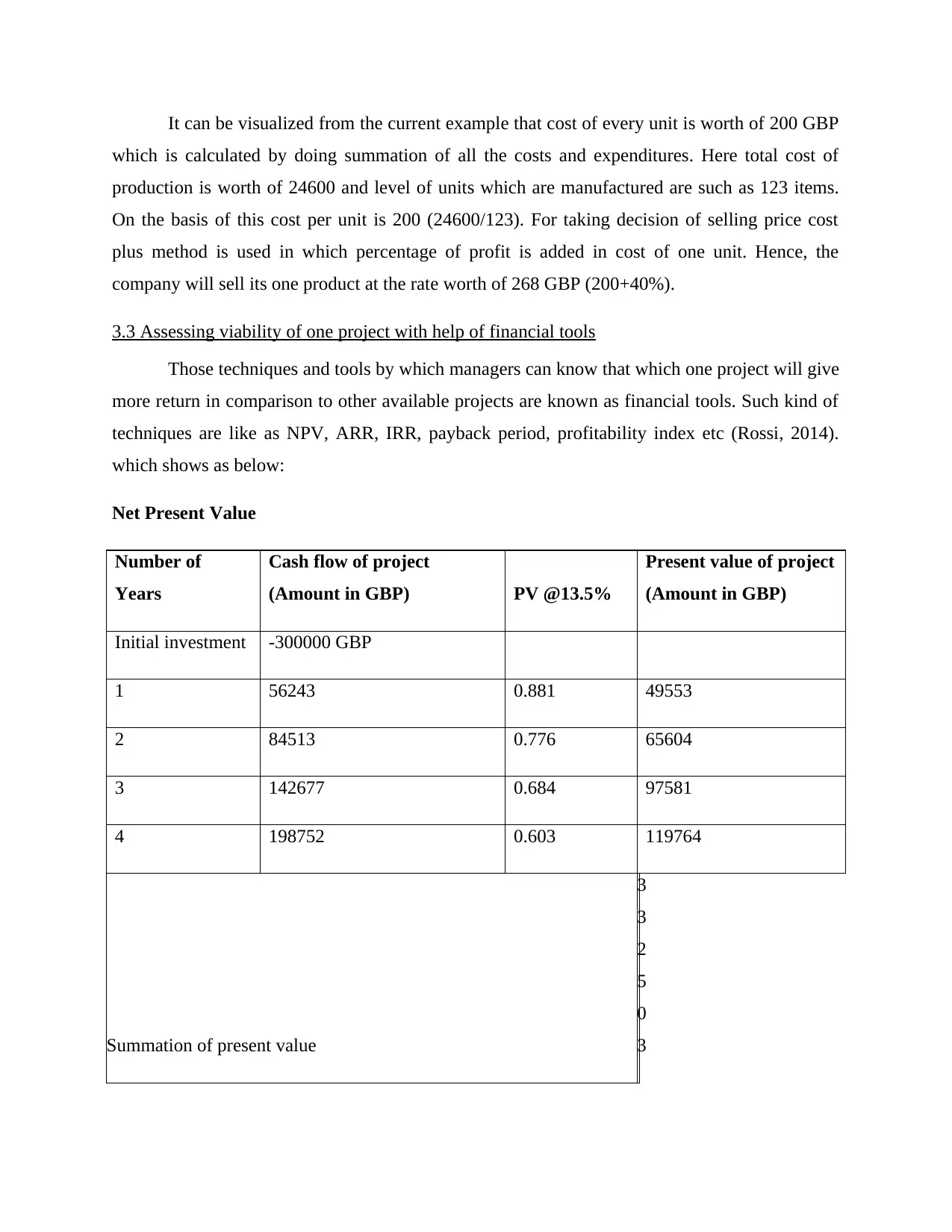
It can be visualized from the current example that cost of every unit is worth of 200 GBP
which is calculated by doing summation of all the costs and expenditures. Here total cost of
production is worth of 24600 and level of units which are manufactured are such as 123 items.
On the basis of this cost per unit is 200 (24600/123). For taking decision of selling price cost
plus method is used in which percentage of profit is added in cost of one unit. Hence, the
company will sell its one product at the rate worth of 268 GBP (200+40%).
3.3 Assessing viability of one project with help of financial tools
Those techniques and tools by which managers can know that which one project will give
more return in comparison to other available projects are known as financial tools. Such kind of
techniques are like as NPV, ARR, IRR, payback period, profitability index etc (Rossi, 2014).
which shows as below:
Net Present Value
Number of
Years
Cash flow of project
(Amount in GBP) PV @13.5%
Present value of project
(Amount in GBP)
Initial investment -300000 GBP
1 56243 0.881 49553
2 84513 0.776 65604
3 142677 0.684 97581
4 198752 0.603 119764
Summation of present value
3
3
2
5
0
3
which is calculated by doing summation of all the costs and expenditures. Here total cost of
production is worth of 24600 and level of units which are manufactured are such as 123 items.
On the basis of this cost per unit is 200 (24600/123). For taking decision of selling price cost
plus method is used in which percentage of profit is added in cost of one unit. Hence, the
company will sell its one product at the rate worth of 268 GBP (200+40%).
3.3 Assessing viability of one project with help of financial tools
Those techniques and tools by which managers can know that which one project will give
more return in comparison to other available projects are known as financial tools. Such kind of
techniques are like as NPV, ARR, IRR, payback period, profitability index etc (Rossi, 2014).
which shows as below:
Net Present Value
Number of
Years
Cash flow of project
(Amount in GBP) PV @13.5%
Present value of project
(Amount in GBP)
Initial investment -300000 GBP
1 56243 0.881 49553
2 84513 0.776 65604
3 142677 0.684 97581
4 198752 0.603 119764
Summation of present value
3
3
2
5
0
3
Paraphrase This Document
Need a fresh take? Get an instant paraphrase of this document with our AI Paraphraser
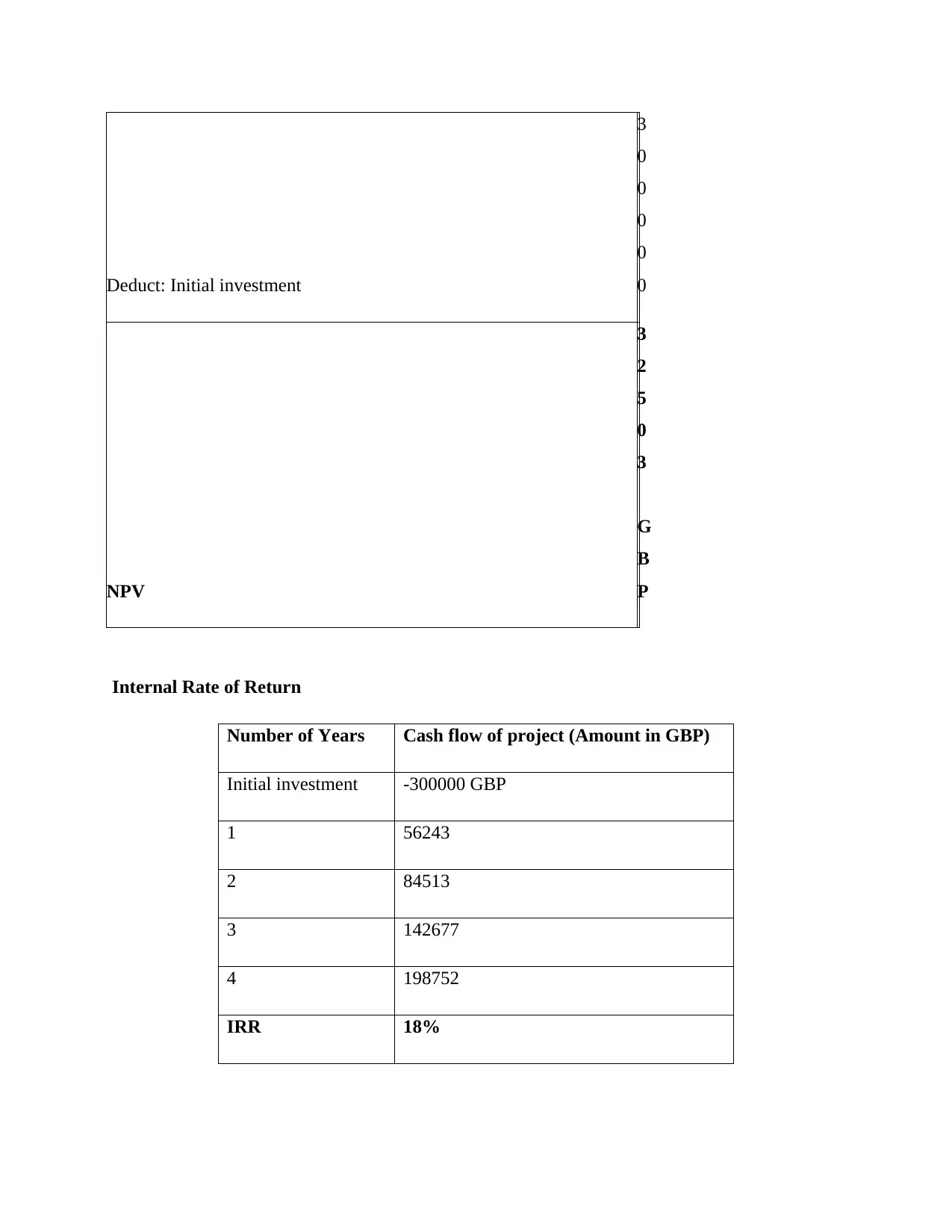
Deduct: Initial investment
3
0
0
0
0
0
NPV
3
2
5
0
3
G
B
P
Internal Rate of Return
Number of Years Cash flow of project (Amount in GBP)
Initial investment -300000 GBP
1 56243
2 84513
3 142677
4 198752
IRR 18%
3
0
0
0
0
0
NPV
3
2
5
0
3
G
B
P
Internal Rate of Return
Number of Years Cash flow of project (Amount in GBP)
Initial investment -300000 GBP
1 56243
2 84513
3 142677
4 198752
IRR 18%
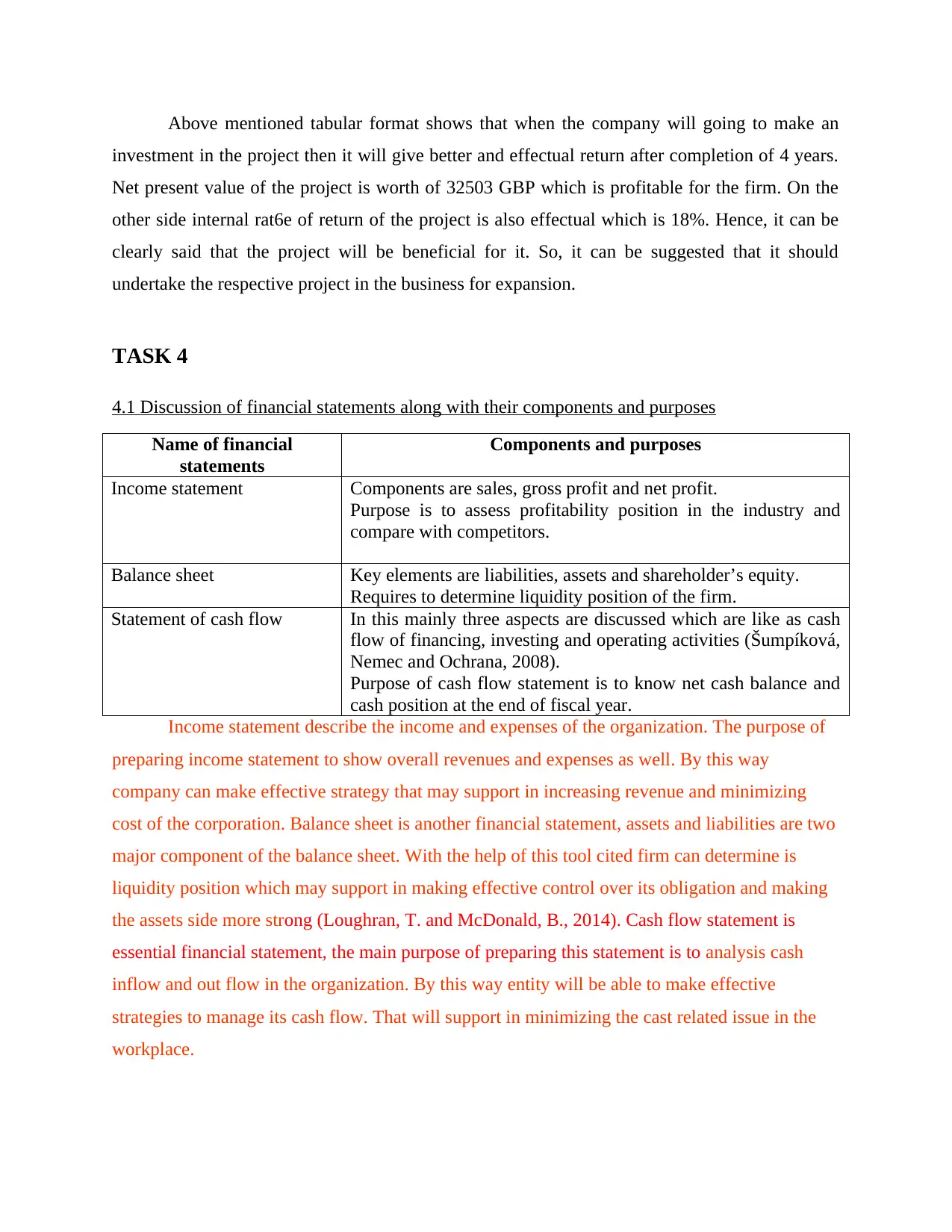
Above mentioned tabular format shows that when the company will going to make an
investment in the project then it will give better and effectual return after completion of 4 years.
Net present value of the project is worth of 32503 GBP which is profitable for the firm. On the
other side internal rat6e of return of the project is also effectual which is 18%. Hence, it can be
clearly said that the project will be beneficial for it. So, it can be suggested that it should
undertake the respective project in the business for expansion.
TASK 4
4.1 Discussion of financial statements along with their components and purposes
Name of financial
statements
Components and purposes
Income statement Components are sales, gross profit and net profit.
Purpose is to assess profitability position in the industry and
compare with competitors.
Balance sheet Key elements are liabilities, assets and shareholder’s equity.
Requires to determine liquidity position of the firm.
Statement of cash flow In this mainly three aspects are discussed which are like as cash
flow of financing, investing and operating activities (Šumpíková,
Nemec and Ochrana, 2008).
Purpose of cash flow statement is to know net cash balance and
cash position at the end of fiscal year.
Income statement describe the income and expenses of the organization. The purpose of
preparing income statement to show overall revenues and expenses as well. By this way
company can make effective strategy that may support in increasing revenue and minimizing
cost of the corporation. Balance sheet is another financial statement, assets and liabilities are two
major component of the balance sheet. With the help of this tool cited firm can determine is
liquidity position which may support in making effective control over its obligation and making
the assets side more strong (Loughran, T. and McDonald, B., 2014). Cash flow statement is
essential financial statement, the main purpose of preparing this statement is to analysis cash
inflow and out flow in the organization. By this way entity will be able to make effective
strategies to manage its cash flow. That will support in minimizing the cast related issue in the
workplace.
investment in the project then it will give better and effectual return after completion of 4 years.
Net present value of the project is worth of 32503 GBP which is profitable for the firm. On the
other side internal rat6e of return of the project is also effectual which is 18%. Hence, it can be
clearly said that the project will be beneficial for it. So, it can be suggested that it should
undertake the respective project in the business for expansion.
TASK 4
4.1 Discussion of financial statements along with their components and purposes
Name of financial
statements
Components and purposes
Income statement Components are sales, gross profit and net profit.
Purpose is to assess profitability position in the industry and
compare with competitors.
Balance sheet Key elements are liabilities, assets and shareholder’s equity.
Requires to determine liquidity position of the firm.
Statement of cash flow In this mainly three aspects are discussed which are like as cash
flow of financing, investing and operating activities (Šumpíková,
Nemec and Ochrana, 2008).
Purpose of cash flow statement is to know net cash balance and
cash position at the end of fiscal year.
Income statement describe the income and expenses of the organization. The purpose of
preparing income statement to show overall revenues and expenses as well. By this way
company can make effective strategy that may support in increasing revenue and minimizing
cost of the corporation. Balance sheet is another financial statement, assets and liabilities are two
major component of the balance sheet. With the help of this tool cited firm can determine is
liquidity position which may support in making effective control over its obligation and making
the assets side more strong (Loughran, T. and McDonald, B., 2014). Cash flow statement is
essential financial statement, the main purpose of preparing this statement is to analysis cash
inflow and out flow in the organization. By this way entity will be able to make effective
strategies to manage its cash flow. That will support in minimizing the cast related issue in the
workplace.
⊘ This is a preview!⊘
Do you want full access?
Subscribe today to unlock all pages.

Trusted by 1+ million students worldwide
1 out of 16
Related Documents
Your All-in-One AI-Powered Toolkit for Academic Success.
+13062052269
info@desklib.com
Available 24*7 on WhatsApp / Email
![[object Object]](/_next/static/media/star-bottom.7253800d.svg)
Unlock your academic potential
Copyright © 2020–2025 A2Z Services. All Rights Reserved. Developed and managed by ZUCOL.





